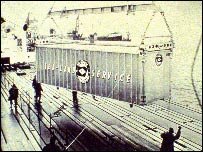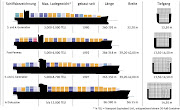In an earlier post I spoke about the Fuel surcharges that the Transportation faces, but failed to point out it has only just begun. The fuel surcharge has helped all industry leaders come close to just breaking even with their fuel expenditures but have not helped bring Carrier profits back up to satisfactory levels as seen in the surcharge raise by the TSA (Transpacific Stabilization Agreement) The TSA is made up of many top name carriers in the Container Shipping Industry and acts as a mediator group for any Industry issues.
Please read below from the American Shipper
Liner carriers in the Transpacific Stabilization Agreement said Monday that their floating bunker fuel surcharge will spike to a record level effective Sept. 1.
"The higher surcharge reflects record fuel prices that topped $767 per ton in mid-July, up from $500 at the beginning of 2008 and $296 at the beginning of 2007," TSA said in a statement.
TSA’s surcharge is adjusted monthly according to a formula that tracks world fuel prices at key loading locations.
Although fuel prices have been falling of late, each month’s surcharge reflects average fuel prices during a reporting period 30 to 60 days earlier, said Bill Payne, NYK Line vice president and TSA revenue policy committee member. This is done to comply with U.S. law requiring a minimum 30 days’ advance notice to the market in the event a particular rate or surcharge is to be raised.
“Carriers pay the higher fuel costs out of pocket as those costs rise, cushioning the impact on shippers, and then must pass them through after the fact,” Payne said. “The good news with a floating formula is that, as prices fall, customers will start to see savings 30 to 60 days out.”
The new fuel surcharges will be $1,886 per 45-foot container, $1,676 per high-cube 40-foot container, $1,490 per 40 footer, $1,192 per TEU and $33 per metric ton or cubic meter.
The TSA surcharge is posted by the carrier group as a guideline for the market, but service contracts with customers -- including bunker surcharge terms -- are addressed individually by the lines.
APL Senior Vice President Bob Sappio, also an RPC committee member, said that while carriers and shippers have made significant progress in agreeing on a floating fuel surcharge, much more work remains.
“If people think the high price of fuel is temporary they are mistaken,” Sappio said. “The transpacific trade is simply not sustainable as it is presently constituted. Carriers must recover a greater percentage of actual dollars spent on fuel.”
TSA members are: APL, “K” Line, China Shipping Container Lines, Mediterranean Shipping Co., CMA-CGM, MOL, COSCO Container Lines, NYK Line, Evergreen Line, OOCL, Hanjin Shipping Co., Yangming Marine Transport, Hapag-Lloyd, Zim and Hyundai Merchant Marine Co.
As you can see, Fuel Surcharges for Carriers has only just begun. As a result the more costs associated with shipping goods, the more it costs to buy the goods, The Trickle Down Effect.
About Me
- Transportation Industry Debater
- North East Coast, United States
- I am a transportation executive and have worked in the container shipping industry for most of my career. I have experience in terminal operations, rail operations, vessel operations, liner management, and contract negotiation. I find myself always searching for something new to learn, as well as other professional opinions about different issues, obstacles, and changes with in the industry. I have searched for a forum to discuss these happenings with other professionals but have found none. For this reason I have decided to create my own. I will put up my opinions and hope for the blog to catch on, so I may read others.
August 26, 2008
Subscribe to:
Post Comments (Atom)







No comments:
Post a Comment